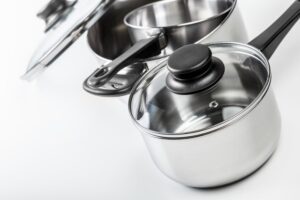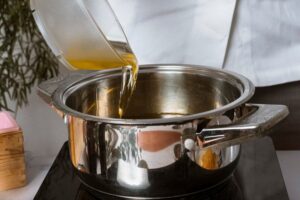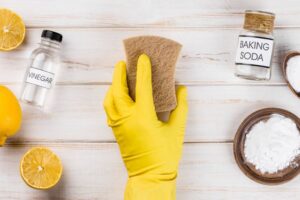What Is All-Clad Stainless Steel?
All-Clad stainless steel refers to the line of cookware made by All-Clad that is constructed using multiple layers of stainless steel and aluminum.

This type of construction provides even heating and durability, making it suitable for various cooking methods and surfaces, including induction cooktops.
Additionally, stainless steel is known for being easy to maintain, resistant to corrosion, and having a polished appearance.
Cladding is the connection of two different metals. It refers to the metallurgical process of coating one metal onto another metal at high temperature and pressure to protect the internal metal from corrosion.
This method differs from fusion welding or bonding as a method of joining metals together.
Process of Steel Cladding
Clad steel is a composite product consisting of a thin layer of high-alloy steel in the form of a thin coating integrally bonded to one or both surfaces of the substrate support material (mild steel).
The primary purpose of such a product is to combine the desirable properties of high alloy steel and support material at low cost for applications where full gauge alloy steel construction is not required.
While the high-alloy steel cladding provides the necessary resistance to corrosion, abrasion, or oxidation, the backing material contributes to structural strength and improves the manufacturability and thermal conductivity of the composite.
Clad steels can be produced as plates, strips, tubes, rods, and wire.
Hot Rolling
In the metal working process, hot rolling occurs above the recrystallization temperature of the material. In fact, recrystallization prevents the metal from hardening.
The material fed for rolling is usually large pieces of metal, such as semi-finished casting products, such as slabs, billets, and blooms.
The product from a continuous casting operation is usually fed directly to the rolling mill at the appropriate temperature.
However, in smaller operations, the material starts at room temperature to be heated. This can be done in gas or oil-fired soaking pits for larger workpieces and for smaller workpieces, induction heating is used.
Cold Rolling
Unlike hot rolling, cold rolling occurs at temperatures below what is normally room temperature. it increases the strength by about 20% higher by hardening the steel and improves the end result in up and maintain tolerances.
Products that often go through the cold rolling process include sheets, strips, and bars; these products are usually smaller than similar hot-rolled products.
This is due to the smaller size of the tool and their greater strength compared to the hot rolled ones. This system uses four-high or cluster drills for its cultivation.
Explosion Bonding

During the bonding process, several atomic layers are applied to the metal surface. The impact angle between the two surfaces then forces the plasma jet ahead of the collision.
This ensures that the surfaces of both metals are scrubbed effectively. What remains is a new layer of metal.
The bond line between the coated metal and the other metal ensures that neither is altered in its original physical or mechanical properties.
The great advantage of explosive bonding is that it is possible to bring together incompatible metallurgical systems. If conventional thermal coating methods are used, the metal can become brittle.
How to Clean All-Clad Stainless-Steel Cookware (Step-by-Step)
Daily Cleaning and Care: To avoid stains and discoloration, preheat All-Clad pans before adding oil, use a high smoke point oil and cook over medium-low heat.
Wash the cookware with dish soap and water after each use and dry thoroughly. Store pans individually to avoid scratches and other damage.
Tips for Cleaning Stainless Steel Cookware
The key to maintaining stainless steel cookware is to avoid scratches, scratches, and chloride deposits from detergents, hard water, or salt. Follow these cleaning tips:
Use the right tools: Always use a non-abrasive sponge or an “approved stainless steel scrubber.” Stay away from mechanically abrasive scrubbers such as steel wool or wire scrubbers. When stainless steel is scratched, it becomes vulnerable to corrosion.
Rub with the grain: Stainless steel has shiny lines that look similar to the grain lines. Always rub parallel to the nail polish lines.
Avoid chlorides: Exposure to chlorides over time can cause pitting of stainless steel, making the surface vulnerable to rust and corrosion. Chlorides are present in salt, hard water, and chlorinated detergents.
How to Clean Burnt Food off Stainless Steel Pans
- Moisten the pan so that the burnt food is submerged.
- Sprinkle Cleaner on the bottom of the pan to form a paste.
- Rinse the pot with clean water.
- If burn marks are still present, repeat the steps.
Cleaning Burnt Food on All-Clad Stainless Steel with Boiling Water
- To eliminate burnt residue in a pot utilizing only hot water, without requiring any industrial cleansers, adhere to the subsequent instructions.
- Initiate by scouring off as much remaining food as feasible with a gentle scrubber that won’t scratch.
- Introduce some dishwashing liquid into the pot after filling it up with water.
- Ensure all remnants of food are soaked by immersing them fully.
- Let the mixture reach a rolling boil before allowing it to gently simmer for several minutes.
- Turn off the stove and move the pot away from the heating element to enable cooling down.
- Dislodge the softened food particles by scraping with a spatula.
- Repeat the procedure if necessary, or consider other methods mentioned if initial attempts prove unsuccessful.
- Always ensure to let your pots or pans cool completely before attempting to handle or store them, to avoid accidental burns.

Remove Burnt Food with Baking Soda from All-Clad Stainless Steel
To clean burned food using vinegar and baking soda, gather these two common household items. The acidity in vinegar helps loosen stubborn food residue.
- First, fill the pot or pan with sufficient water to submerge the burnt areas.
- Next, introduce 1 cup of vinegar to the water and place it on heat until boiling occurs.
- After reaching a boil, take the pot off the stove and put in 2 tablespoons of baking soda while stirring briefly.
- Empty the mixture out of the pan.
- Lastly, use a gentle scouring pad to eliminate any lingering food debris.
By following these steps, you should be able to successfully remove the charred food particles from your cooking utensil.
Remember, this process should be performed using mild solutions and non-abrasive tools to prevent further damage to the pot or pan.
Removing Discoloration with Vinegar
Vinegar serves as a useful agent in eliminating unpleasant discoloration on pans, which often results from excessive heat exposure. To do this, just clean the pan using vinegar and then rinse it off with water.
Furthermore, vinegar can also be utilized to get rid of stubborn white calcium deposits in pots or pans.
Create a solution consisting of equal portions of vinegar and water (three parts water to one part vinegar), bring it to a boil in the afflicted cookware, let it cool down, discard the liquid, and proceed to clean it as you normally would.
To conclude, if you’re struggling with stubborn stains or discoloration on your pots or pans, don’t hesitate to try the simple yet effective vinegar solution. It may just be the ticket to restoring the luster of your cookware.
Conclusion
By following these guidelines, you can ensure your All-Clad stainless-steel stuff remains clean, lustrous, and free from damage.
